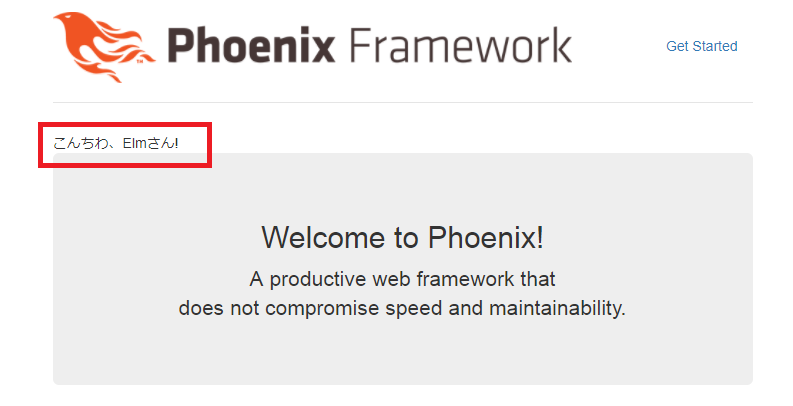追記:最新版のphoenix1.3とElmについてはこちらの方を参照してください。
ElmからPhoenix v1.3のRest APIを叩いてみる - Qiita
Elmのバックエンドとして、Phoenixを使いたいと思いました。そのためにElixirやPhoenixを少し勉強しました。今回はその出発点になる知識をメモっておきたいと思います。以下のサイトを参考にしました。
Phoenix and Elm, a real use case (pt. 1) - Code, Love & Boards
Setting up Elm with Phoenix – Brandon Richey – Medium
今回は単にPhoenixのフロントエンドとしてelmの単純な画面を表示するだけのプログラムを作ります。まず以下の手順でElmとElixir、Phoenixのインストールを行っていると仮定します。
Elm開発環境について - Qiita
CentOS7にErlangとElixir、Phoenixをインストールしてみる - Qiita
Phoenixでは、Brunchを使って、静的なアセットをビルドしています。Elmコードはbrunchに従ってコンパイルされ、ロードされます。幸いなことに、ElmコードをコンパイルするためのBrunch pluginであるelm-brunchが利用できます。さっそくプロジェクトを構築していきましょう。
Phoenixのプロジェクトを作成します
mix phoenix.new phoenix_elm_test
elm-brunchをインストールします
cd phoenix_elm_test
npm install --save-dev elm-brunch
brunch-config.jsを編集します。2か所の追加が必要です(追加1と追加2)。
exports.config = {
// See http://brunch.io/#documentation for docs.
files: {
javascripts: {
joinTo: "js/app.js"
},
stylesheets: {
joinTo: "css/app.css",
order: {
after: ["web/static/css/app.css"] // concat app.css last
}
},
templates: {
joinTo: "js/app.js"
}
},
conventions: {
assets: /^(web\/static\/assets)/
},
// Phoenix paths configuration
paths: {
// Dependencies and current project directories to watch
watched: [
"web/static",
"test/static",
//-------------追加1
"web/elm"
//-------------
],
// Where to compile files to
public: "priv/static"
},
// Configure your plugins
plugins: {
//-------------追加2
elmBrunch: {
elmFolder: "web/elm",
mainModules: ["Main.elm"],
outputFolder: "../static/vendor"
},
//-------------
babel: {
// Do not use ES6 compiler in vendor code
ignore: [/web\/static\/vendor/]
}
},
modules: {
autoRequire: {
"js/app.js": ["web/static/js/app"]
}
},
npm: {
enabled: true
}
};
特に追加2のoutputFolderに注目してください。一般的にvendorフォルダはBrunchによってこれ以上変換(コンパイル)されないファイルの置き場所で、そこのファイルは全て、appプログラムの前にロードされ、連結されるという決まりのようです。以下で見るようにjs/app.jsからVendor/Main.js(Elmのコンパイル結果)を参照していますが、特にNotFoundエラーも出さずに、Elm.Mainモジュールを利用できます。
http://brunch.io/docs/config
http://brunch.io/docs/concepts
次にweb/elmディレクトリを作成しcdして、Elmコードに必要なパッケージをインストールします。今回のElmコードにはelm-lang/htmlだけでokです。
mkdir web/elm
cd web/elm
elm-package install elm-lang/html
# elm-package install elm-lang/http
# elm-package install simonh1000/elm-jwt
次にweb/elm/Main.elmを作成します。
module Main exposing (..)
import Html exposing (Html, text)
main : Html msg
main =
text "こんちわ、Elmさん!"
次にweb/templates/page/index.html.eexを編集して、先頭に以下の行を追加します。
<div id="elm-container"></div>
最後にweb/static/js/app.jsを編集して、末尾に以下の2行を追加します。Elm.Mainは当然 web/static/vendor/Main.jsを参照していますが、前述の通り、特に明示的なimportなどは必要ないようです。
const elmDiv = document.querySelector("#elm-container")
const elmApp = Elm.Main.embed(elmDiv)
編集が終了したので、プロジェクトのトップに戻り、以下のコマンドを打ちプロジェクトを立ち上げます。
mix ecto.create
mix phx.server
Phoenix起動時にElmコードがコンパイルされた旨のメッセージが確認できます。
[info] Running PhoenixElmTest.Endpoint with Cowboy using http://0.0.0.0:4000
Elm compile: Main.elm, in web/elm, to ../static/vendor/main.js
10:16:47 - info: compiling
10:16:50 - info: compiled 66 files into 2 files, copied 3 in 10.3 sec
ブラウザからアクセスするとElmコードの出力が確認できます。
http://www.xxxx.jp:4000/
以下は画面キャプチャーです。
これで、Phoenixプロジェクトの中でElmが使えるようになりました。Webアプリの骨格を成すものができた感じで、うれしいです。
